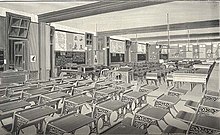Francis M. Drexel School
Francis M. Drexel School | |
| NRHP reference No. | 86003272[1] |
|---|---|
| Added to NRHP | December 4, 1986 |
The Francis M. Drexel School was a historic
The school was named for
The school

At the time of the Drexel School's construction, Philadelphia's school system had a decentralized administration, with Drexel being a part of the Twenty-sixth Section.[3] The school buildings, however, were designed by the central administration.[4]
The Drexel family was intensely involved with education at this time. Anthony J. Drexel, as the partner of
Completed in 1889,[2]: 2 the Drexel School included features common to late nineteenth-century Philadelphia schools. Earlier schools were generally built entirely of brick, and the 1870s saw the introduction of stone schools, but schools built between 1883 and 1900, including Drexel, typically combined brick walls and brownstone finishing.[4]: 6
Anschutz worked in the tradition of Samuel Sloan's "Philadelphia Plan" of school architecture: On each floor, classrooms opened onto a single corridor, and were divided by moveable partitions. Coatrooms were provided in each classroom. Stairways and other non-classroom space were located at the end of the corridor, near the outside of the building.[4]: 9–10 The architectural plans closely follow these principles. The school's windows were enlarged in 1914, and in 1922, lighting was changed from gas to electric.[8]
Although it originally housed classes for both
Recognition and demolition
In 1986, the Francis Drexel School was listed on the
The Drexel School was demolished in February, 2010.[9]
Gallery
-
Crews preparing to demolish the school
-
Exterior of the school as demolition begins
References
- ^ a b c d "National Register Information System". National Register of Historic Places. National Park Service. March 13, 2009.
- ^ a b c d Mintz, Elizabeth. Pennsylvania Historic Resources Survey: Francis M. Drexel School. Harrisburg: Pennsylvania Historical and Museum Commission, August 1986. Accessed 2010-02-15.
- ^ a b Custis, John Trevor. The Public Schools of Philadelphia: Historical, Biographical, Statistical. Philadelphia: Burk & McFetridge, 1897, pp. 429-435.
- ^ a b c d e f Moak, Jefferson M., et al. National Register of Historic Places Inventory/Nomination: Philadelphia Public Schools Thematic Resources. National Park Service, August 1986. Accessed 2010-02-15.
- ^ Childs, George W., in Harper's Weekly, reprinted as "Two Noble Lives" in the Pennsylvania School Journal, V. 42, Sept. 1893, pp. 102-104.
- ISBN 081221966X. 9780812219661. Ch. 13 "Two Social Revolutionaries" pp. 149-161
- ^ Loughlin, James F. (1913). Charles George Herbermann (ed.). The Catholic Encyclopedia, Volume 5. Encyclopedia Press. p. 159., p. 159
- ^ Original architectural drawings are available online at www.thedrexelschool.com sub-page "Blueprints"
- ^ View of the school provided by this picture
External links
- Francis M. Drexel School
- Demolition Photostream on Flickr
- Francis Drexel School Farewell on Flickr
- PlanPhilly - Older Public School Buildings Archived 2011-02-11 at the Wayback Machine
![]() Media related to Francis M. Drexel School at Wikimedia Commons
Media related to Francis M. Drexel School at Wikimedia Commons




